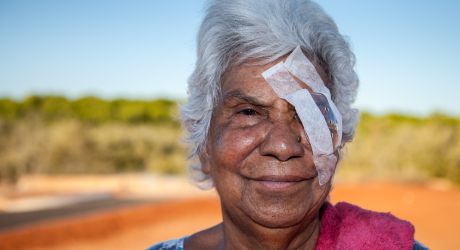Project Background
This project is part of ongoing work undertaken by the Fred Hollows Foundation in remote Aboriginal and Torres Strait Islander communities in remote Australia.
Indigenous children have better vision than the mainstream population, however Aboriginal and Torres Strait Islander adults are six times more like than other Australians to go blind.
94% of vision loss among Aboriginal and Torres Strait Islander adults is preventable or treatable. The four eye conditions that cause this vision loss are: refractive error (needing glasses), cataract, diabetic retinopathy and trachoma. The statistics show how easily achievable it is to prevent avoidable blindness – most vision loss can be corrected overnight or with a pair of glasses. However, 35% of Aboriginal and Torres Strait Islander adults have never had an eye exam.
A major issue in remote Aboriginal communities is trachoma, an infection of the eye that can lead to irreversible blindness. Australia is the only developed country to still have trachoma. The Fred Hollows Foundation is to end trachoma in Australia by 2020.

Project Outcomes
Thanks to the support of our generous donors, The Indigenous Aus-tralia Program has achieved great results to date in 2016.
Particularly, outreach to remote and under-serviced communities has resulted in over 7,000 people having their eye screened, and 936 people receiving sight restoring operations and treatments.
Education and advocacy about eye health are essential to the work of The Fred Hollows Foundation. Particularly, there were 333 school children and community members educated in eye health, including trachoma, an infectious eye infection that can lead to irreversible blindness. Australia is the only developed country that still has this disease, which is linked to poor living conditions and sanitation.
Furthermore, through The Foundation’s advocacy measures, the In-digenous Australia Program is working with governments to ensure sustained investment in high quality, accessible and cultural appro-priate eye care services to remote and under-serviced communities in Australia.
Between Q1 and Q3 of the program, the following results were achieved:
- 7,298 people screened in remote and under-serviced communities
- 936 eye operations and treatments performed, including 339 cateract operations
- 1,760 pairs of glasses distributed
- 78 health professionals and community workers trained
- $385,000 worth of equipment supplied to medical facilities
- 333 school children and community members educated in eye health
What's next?
There is always more work to be done as we strive to end avoidable blindness. The Foundation relies on the continued support of our generous donors to achieve Fred’s dream of a world where no one is needlessly blind.
In 2017, The Foundation’s Indigenous Australia Program will continue to improve the health outcomes of Aboriginal and Torres Strait Island people. Projected outputs include:
- 11,190 people screened
- 955 cataract operations performed
- 450 diabetic retinopathy treatments performed
- 1,760 pairs of spectacles distributed
- 28 clinic staff and community health workers trained
Can I visit this project?
Interested donors should contact the Foundation directly
Project Background
Indigenous children have better vision than the mainstream population, however Aboriginal and Torres Strait Islander adults are six times more like than other Australians to go blind.
94% of vision loss among Aboriginal and Torres Strait Islander adults is preventable or treatable. The four eye conditions that cause this vision loss are: refractive error (needing glasses), cataract, diabetic retinopathy and trachoma. The statistics show how easily achievable it is to prevent avoidable blindness – most vision loss can be corrected overnight or with a pair of glasses. However, 35% of Aboriginal and Torres Strait Islander adults have never had an eye exam.
A major issue in remote Aboriginal communities is trachoma, an infection of the eye that can lead to irreversible blindness. Australia is the only developed country to still have trachoma. The Fred Hollows Foundation is to end trachoma in Australia by 2020.
Despite great improvements, there’s still a lack of access to high quality, accessible and culturally appropriate eye care services in Aboriginal and Torres Strait Islander communities in remote and underserviced communities in Australia.
The Foundation works with partners to advocate to governments for sustained investment in services to improve eye health and to close the health inequality gap between Aboriginal and Torres Strait Australians and the rest of the Australian population by 2030.
.jpg)
Project Aim
The Fred Hollows Foundation focuses on providing high quality, accessible and culturally appropriate eye services to remote and under-serviced Aboriginal and Torres Strait Islander communities in Australia.
We concentrate on cataract, diabetic retinopathy, refractive error and trachoma, and invest in programs across Australia to:
- Address ophthalmology workforce shortages
- Coordinate and improve outreach eye services
- Improve patient experience and integrate eye care in the primary health care system
- Build strategic alliances and advocate to government for sustained investment in eye care
Key Project Objectives
In 2016, the Indigenous Australia Program will achieve the following objectives:
- Screen 12,315 people
- Support 1,040 cataract operations
- Support 350 Diabetic Retinopathy procedures
- Support the distribution of 2,950 spectacles